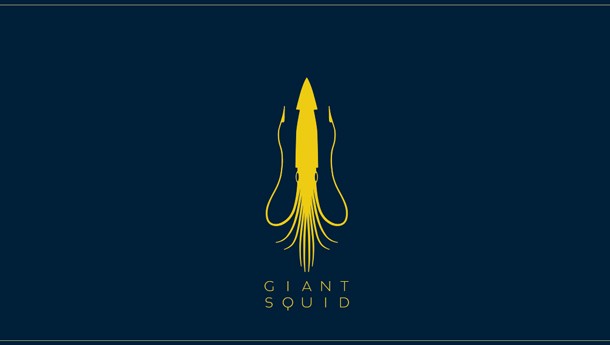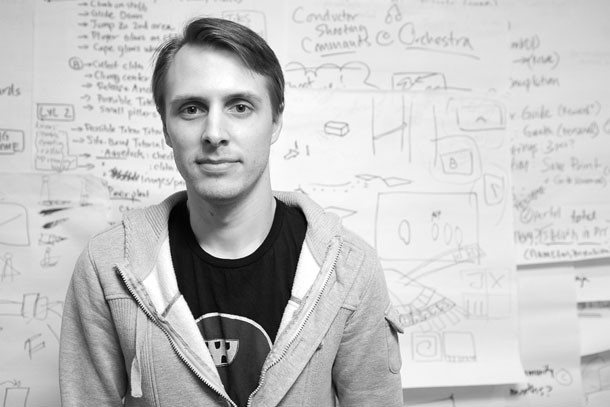Former Thatgamecompany Art Director Talks The Future Of His New Development Studio

Matt Nava used to be the art director for thatgamecompany. His artistic sensibilities set the visual tone for games like Flower and Journey. He recently left the studio in pursuit of his own game development dreams, and created Giant Squid, a small studio with a grand vision. We spoke with Nava to find out why he would leave a company that clearly values artistic talent, what Philip Seymour Hoffman has to do with his games, why he thinks Game Boy games are so elegant, and what we can expect from Giant Squid in the future.
 Can you you tell me about your background with game development? What got you into making games?
Can you you tell me about your background with game development? What got you into making games?
I was pretty much straight out of school grinding through the industry. I went to school at Otis College Of Art and Design here in LA, studying digital media, art, and doing graphics and things like that. I was very fortune to meet Jenova Chen at my senior thesis show. Pretty much right after that, I came into work on Flower as the art director, helped them finish up that game, and it was Journey from there. Journey was really the first game that I’ve worked on from start to finish. It’s all moving very quickly.
What exactly does an art director do in the context of developing video games?
I can only really speak from my own experience. I know that a lot of art director roles are very different across different companies, especially depending on team size, but at a small company like Giant Squid or at thatgamecompany, art director is in charge of a lot of everything. With the art, basically I was responsible for creating the graphics of Journey and maintaining the quality of the visuals in the game. I did all the concept art and texturing and a lot of 3D modeling and animation for that game. I don’t know, I think a lot of people have the assumption that art director is more of a managing role, but in my experience it was a very hands-on thing because it was a small team and so we were just making most of the art. That’s it.
Yes, the title of ‘director’ implies that you’re not really doing a lot of drawing.
Right. I did tons and tons of drawings. I think that’s the thing I did most of.
Is that the role that you will be inhabiting with Giant Squid? Art director? Or is it going to be something different?
Well, what I found was as I worked on Journey, as we moved forward through that project, I did more and more design work, level design work, and a lot of feedback into the actual game and things like that. At Giant Squid my role is now creative director. That’s the title anyways, and I think what it basically means is that I will be doing the stuff that I did for Journey in terms of art, because that’s my specialty. But, then I will also be directing the overarching story idea in the game and things like that. Making sure that the overall design of the game is coherent and everything. Everybody is working together and things like that.
People admire thatgamecompany for its art, so it seems like it would be the perfect place for an art director. What made you want to branch out on your own and start Giant Squid?
I really enjoyed working at thatgamecompany. The people there are super smart and fantastic developers, really good at what they do, and I learned so much from them when I was working there. I still have a big connection with those people. I think after I worked on Journey, I was really ready – I had a bunch of my own concepts and I kind of wanted to see if I could do that. I know about the next project they are working on and it’s really cool, but I decided that I would rather spend my time focusing on building a studio, building a team and trying to work on my own thing. I am really excited to see how their project turns out as well. Does that answer your question?
The Journey composer, Austin Wintory, and the designer/engineer, Nicholas Clark, are working with you as well, correct?
That’s correct. Nick is still working at thatgamecompany and he is also working as an advisor. He is an extremely talented programmer, knows a lot about the game developing process, helping us get our whole pipeline set up, and hiring programmers and their team.
Austin Wintory is an incredibly talented composer and it’s amazing to work with a composer like him. He can work on so many things. I think he has worked on more than 10 games since Journey came out. It’s crazy the amount of things that he can do at the same time. He is going to be composing the music for our game, which I am really excited about because he brings a really amazing mood to the experience. So, yeah it’s very cool.
How many people are working with you at Giant Squid?
Currently we are in the process of hiring and we are going to be starting out with about five people, hopefully getting up to about 10 people. We are going to keep it a very small team. I have a big belief in the power of a small team to create really innovative work, and that’s really something that Giant Squid is focused on doing.
I know you are not ready to talk specifics about what you are working on, but can you say what kind of platform you are interested in releasing on? Are you working on something mobile, or is it something for console or PC?
We’ve got a game concept and we’ve been developing it for a few months, and the whole future of next-gen consoles is about to become much more clear. That’s kind of what we are targeting, PC and the next-gen consoles possibly. It’s all up in the air right now, but hopefully we will be able to deliver the product to as wide range of people as we possibly can. That’s our goal.
Click to page two to find out out more about Giant Squid's future, and Nava's love for the simplicity of the Game Boy era.

Can we expect to see similarly art-focused games like those from thatgamecompany?
Yeah, I think one thing that I really learned with Journey was, like I said, I was kind of straight out of school. I didn’t know if I was going to go into games, visual effects, film, animation, or other things like that. What I learned on Journey was that games are really what I enjoy doing and it’s really where I can pursue my creativity and my art. Giant Squid is definitely a place where I hope to do that. I want to be able to make the kind of games that are visually stunning, experimental, and really try to push the art game genre to its limits and try new things with it.
You’ve partnered with Ink Factory, a company I’m not familiar with. What is the Ink Factory is and how does it relate to Giant Squid?
The Ink Factory is a new production company based in the UK and LA. They create movies. They are just completing their first movie, Most Wanted Man, with Philip Seymour Hoffman. They have a bunch of other cool projects for TV and things in development. The thing that Ink Factory is really all about is they are obsessed with storytelling, narrative, and creating a kind of thoughtful movie experience for people.
Our collaboration with them is really cool to me because it’s kind of – Giant Squid studio kind of becomes the intersection of these talents from different industries and there’s kind of this cool overlap where we’re going to be seeing a lots of creative people with lots of creative ideas coming in and out. It’s going to be really invigorating to the creative space, I think, as a studio.
Are they working with you on a creative level or are they serving a publisher role?
Right now what happens is they are co-owners of the Giant Squid company, and so what they’re really interested in doing is becoming kind of a trans media company where they are putting out creative content on all sorts of platforms. They are really interested in getting into the gaming space. and so Giant Squid Studio is kind of a way for them to understand that space. For me it’s a place where I have complete freedom to do the kind of games that I envision, and they are there to support and help make that happen.
It seems like a non-traditional relationship. Are they looking over your shoulder to see how game development works? Are they helping to fund Giant Squid?
Yeah, they’re helping fund us. They have a lot of very interesting IP that they might want to try making into games. When I first talked to them about it I said, “You know, I think that really what I want to do with my kind of studio is to create our own IP,” and so they said, “Yeah, that’s what we want. We don’t want to be forcing IPs down your throat.”
It’s kind of like a first-look basis. If we make a cool IP and they want to make a movie out of that IP, they have the first choice to do that before we go to other people. Things like that, and we have the same thing for IP that they have for games, but there’s no kind of thing where either company is forced to make a movie out of a game or something like that, because it could be a complete disaster and that’s not what we want to do. We want to make things that are really super great, but really allow this kind of cross pathway between the companies for potential projects. We really don’t know what that could be, but games are evolving and movies are evolving, and who knows what the intersection may be in the future. That’s what we’re interested in.
Is there a story behind the name Giant Squid, or are you just a fan of giant squids?
I definitely am a fan of giant squids. I’m actually a really big fan of animalia and all sorts of ancient creatures, and giant mysterious creatures, and things like that. But the name Giant Squid – it’s actually funny because the Ink Factory has this ink name, and we were trying to think of some cool name that would go with ink, and everything that possibly has a connection with ink sounds like a tattoo parlor. So, Giant Squid was kind of cool because squids shoot ink and that sort of thing. But definitely also has to do with my obsession with cool creatures like that.
What are some of your favorite games that you grew up on, or games that you’re playing now?
I grew up on the Game Boy and the Nintendo 64. Those were my favorite when I was a kid. Ocarina of Time, Mario Kart 64 – I played all those kind of games. But I think one thing is that I’ve been going back and playing some old Game Boy games. I found that what I really liked about those – I really liked Link’s Awakening, Metroid II: Return of Samus – is that these games were really limited. I also liked Mega Man 4 on the Game Boy.
It’s funny because I never had the Super Nintendo or the Nintendo system, so I never saw the – like Mega Man 4 was also on those consoles – in full color. I never saw that when I was a kid. I played this black and white version that was cut down and it was really just no fat. There are no extras, just the core mechanics: really elegant, and black and white. They were very atmospheric and very elegant in a way that the color versions weren’t, and that’s something that I think rubbed off on me in my sense of design.
I really enjoy just very simple but effective use of graphics, sound, and narrative to achieve an experience That is atmospheric, and that’s something that I think you can see in Journey and Flower. Hopefully it’s something that will carry on into the games we make at Giant Squid.
When will be able to learn more about what you’re working on?
I don’t think we’re going to be ready to announce our projects for some time. We’re just going to be hunkering down and working on it, and hopefully it will be really cool.
Special thanks to GI interns Louis Garcia and Kayla Herrera for their helpful transcription services.

Get the Game Informer Print Edition!
Explore your favorite games in premium print format, delivered to your door.
- 10 issues per year
- Only $4.80 per issue
- Full digital magazine archive access
- Since 1991









